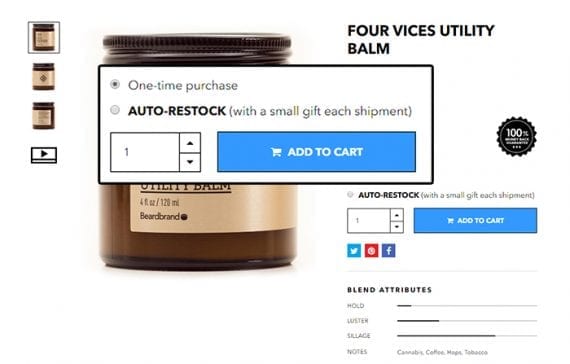The ecommerce subscription model offers retailers several operational benefits, including relatively better marketing results, higher customer retention rates, improved margins, easy inventory management, and less expensive shipping.
Subscription ecommerce businesses take many different forms and serve many different niches. What they have in common is the sort of customer need or problem they address. Very often these problems or needs include some form of product replenishment, product discovery, or a service.
Ecommerce subscriptions might be a standalone service, such as BarkBox or BirchBox, or an option from a retailer willing to sell products to you repeatedly. For example, a shopper could purchase four ounces of Four Vices beard balm from Beardbrand as a one-time order or choose Beardbrand’s “auto-restock” option to receive the balm regularly.

Retailers like Beardbrand are willing to sell you a product once or via a subscription.
This means so-called transactional retailers can also offer subscriptions and enjoy some of the benefits, including the five listed here.
1. Return on Marketing Investment
Ecommerce subscription businesses should offer a very good return on the marketing investment since a newly acquired customer is likely to make repeated purchases.
For nearly any online retail business, new customer acquisition is common marketing goal. It can also be one of the most expensive marketing investments a business makes. But with a subscription service, your return on investment or return on advertising spend is almost certainly better than a business that offers only one-time sales.
Imagine that you sell a widget for $50. You buy this widget from your supplier for $25. On average, it costs you $10 to acquire a new customer for your widget, so you end up earning about $15 profit on each widget. Put another way, a $10 marketing investment returns $15 in profit.
Now imagine that you also offer a subscription “auto-restock” option for new customers, too. If a shopper subscribes and makes just two purchases before canceling her subscription, your return increases. You earn a total of $40 profit on the two transactions, but still only spend $10 to acquire the customer. A $10 marketing investment returns $40 in profit.
2. High Customer Retention
The previous example assumed that your widget subscriber would cancel (churn) after just two orders. But in reality, your ecommerce subscription business might enjoy a better customer retention rate.
While very few in the industry are willing to guess at an average customer retention rate for subscription business relative to the retention rate for other retail business models, many insiders will tell you to expect better rates for subscriptions.
In short, with a subscription offer your customer will buy again and again.
3. Good Retail Margins
Some ecommerce subscription businesses have reported better retail margins as compared to the those from one-time sales of individual products. While several factors can contribute to these improved margins, they result from either selling the products for more or having lower costs associated with selling the product.
The first opportunity, selling products at a higher price, can be the case for “box” subscription services that package several products together for a set price. If you order a $25 box of new shoelaces, you might not individually price each lace. Thus, the retailer can charge a bit more for some laces.
The second opportunity, having lower costs associated with a subscription sale, is possible, in part, because of predictability. Since you know ahead of time what you will sell next month, you can optimize inventory, packaging, and shipping.
4. Easy-to-manage Inventory
Your ability to optimize inventory, which lowers your costs, comes from knowing what you will sell ahead of time.
If you have 100 subscribers to your sardine-of-the month box, you know you will need at least 100 cans of this month’s sardines. This means that you can place the proper order from your sardine supplier with confidence, and if the quantity is sufficient, you may even get a better discount, placing orders for several months in advance.
Compare this to inventory management for a traditional retail business model. How would you know how many sardines to order next month? You would consider sales history, taking into account seasonal differences in sardine consumption, seasons, and so on. But you would not have as clear of a picture.
With the subscription model, it is easier.
5. Low Cost Shipping
The ecommerce subscription model can also result in lower shipping costs. Your customer expects to receive an order on a schedule. Maybe it’s an order each week, month, or quarter.
All your customer cares about is that the order arrives on time. You can ship it when it makes sense for your business. These means that you can choose relatively slow and inexpensive ways to ship your subscription orders.
For a transactional ecommerce business, you really want packages to arrive in a few days from the date the customer orders. With subscription fulfillment, you can have a package take two weeks. Your customer won’t care, as long as the items arrive when expected.
You might also optimize shipping with special packaging or using fulfillment services with warehouses near your subscribers.





